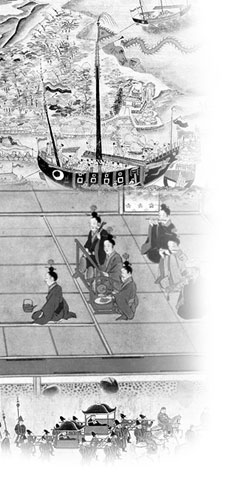
 |
Okinawan music began before the 11th century in prayers for a fertile harvest of grains, to protect against calamity and pray for good health. Examples of the sacred songs performed at these religious ceremonies include the Umui folk songs, the Kwena wishing songs, the Otagabe incantation songs, the Miseseru incantation songs. These songs eventually became the basis for the refined ballads called Omoro. At the beginning of the 16th century, the Omoro ballads sung on Amami and Okinawa were collected together by the royal government and compiled into the Omoro-soushi, a piece of literature comparable to the Manyoshu of mainland Japan. Also based on the old songs and ballads, there were songs and dances called Ushideku that started to be performed in agricultural and fishing villages during ceremonies. The lyrics of Ushideku are sung in the 8-8-8-6 meter so it is thought that the Ryuka genre was being formed around this time. From the 14th to 15th centuries the Sangen was introduced via the trade with China and this instrument became the Sanshin (Okinawa samisen). This was added in accompaniment to the melodies of the existing ballads and Okinawa classical music was born. From then on Chinese style music was also transmitted to Okinawa. This was the court and processional music called Uzagaku and Rujigaku. The genres were developed by the royal government as court music. With the advent of Okinawan classical music many diversely talented musicians emerged who polished the music to a still higher degree of refinement. In the 17th century the Jodo sect of Buddhism was brought in from mainland Japan Taichu and it is said that Nembutsu songs were created to adapt the teaching to suit the people of Okinawa. These Nembutsu Buddhist chants became Eisa folk dances.In the latter half of the 19th century, with the dissolution of the Ryukyuan Kingdom, Okinawan classical music left the confines of the court and was changed by the common folk. After the end of WWII, Okinawa entered the period of rule under the U.S. military. During that era the Shimauta folk songs had a sudden rise in popularity to cheer up a people who were devastated by war. The military bases themselves had a tremendous influence on Okinawa's music. Examples of this would be the jazz bands that came out of exposure to the music on the bases, the first cries of Okinawan rock that emerged from the busy towns around the bases, the 60's style folk songs that were carried on the waves of the Okinawa reversion, as well as the genre Okinawan Pops. Particularly with Okinawan Pops, the western music heard around the bases fused with traditional music to create a unique World Music. At present, as we enter the 21st century, the hardcore rock music of Okinawa is receiving a great deal of attention. Okinawan music that started from ancient sacred songs has diverged through the ages into a multitude of styles as numerous as the stars in the night time sky, a process that continues even today. |
|
| Photo : Okinawa Prefectural Museum, Hiroshi Shimabukuro | ||